

With their exotic plumage and tiny stature, the Hummingbird is one of the most beautiful birds you’ll ever see. But, how many species are there in the great State of Georgia?
There are a total of 12 Hummingbird species you can spot in Georgia. Below, we’re going to take a detailed look at these 12 species including their identifying characteristics, habitat, diet, and more. So, what are you waiting for?
Let’s dive straight in and start learning more about the 12 you can find in Georgia.
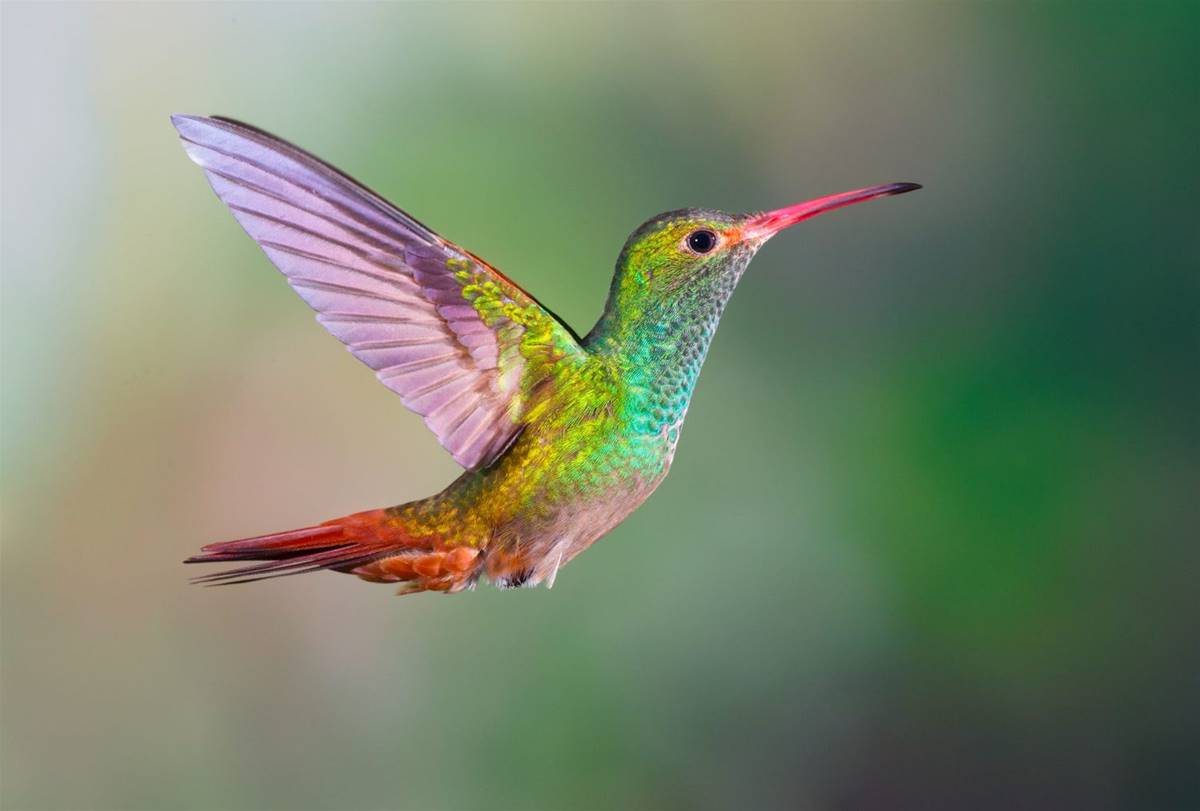
If you haven’t got the time to read about each of Georgia’s Hummingbird species and simply want a quick reference list, we’ve got you covered. The 12 species of Hummingbird you can find in Georgia are:
Broad-Billed HummingbirdAnna’s HummingbirdCalliope HummingbirdGreen-Breasted MangoBlack-Chinned HummingbirdRivoli’s HummingbirdBroad-Tailed HummingbirdRuby-Throated HummingbirdAllen’s HummingbirdBuff-Bellied HummingbirdBlue-Throated Mountain GemRufous HummingbirdNow, let’s take a look at each of Georgia’s Hummingbird species in more detail.
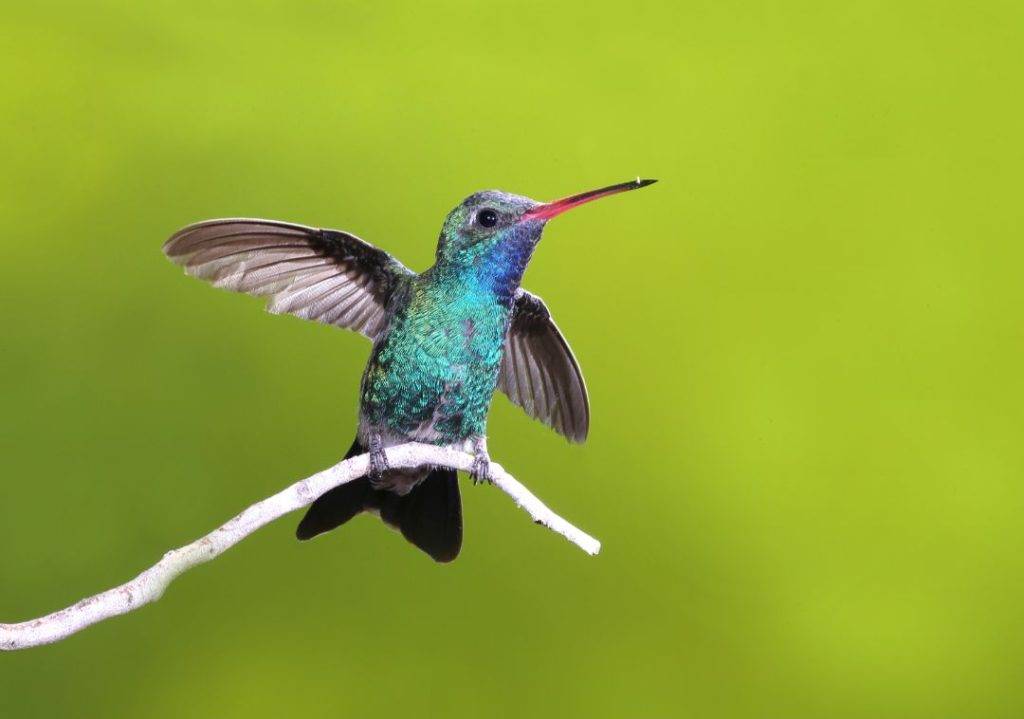
The Broad-Billed Hummingbird is native to parts of the Southwestern United States, including Arizona, New Mexico, and Texas, as well as Mexico and Central America.
It is possible that Broad-billed Hummingbirds may occasionally be seen in Georgia during migration, but they are not common in that area and would not be expected to be found there regularly.
They also typically migrate to Central and South America for the winter months.
Broad-billed Hummingbirds are small, brightly colored birds. They have a metallic green head and back, a red throat, and a thin, curved bill that is bright red at the base and black at the tip.
The underside of the bird is mostly white, with some fine, dark streaking. The wings are short and rounded, and the tail is relatively long and has elongated central feathers.
Adult males and females are similar in appearance, but males tend to be slightly larger and have a more brightly colored throat.
Juvenile birds resemble the adults, but they may have a less vibrant coloration and more streaking on their underparts.
Broad-billed Hummingbirds primarily feed on nectar from flowers, using their long, thin bills and brush-like tongues to extract the sweet liquid.
They also consume small insects and spiders, which they catch while in flight or while perched.
These small animals provide protein and other nutrients that are important for the hummingbirds’ health and reproduction.
Broad-billed Hummingbirds are attracted to a variety of flowering plants, including agave, desert willow, and ocotillo, as well as hummingbird feeders that contain a solution of sugar water.
They are active during the day and feed frequently to fuel their high metabolism.

Anna’s Hummingbirds are native to the West Coast of the United States and Mexico, but they have also been known to spend the winter in Georgia.
You can identify Anna’s Hummingbird by the bright metallic green feathers on its back and crown.
They also have a long, straight, and slender beak that is well adapted for reaching nectar in flowers.
The male Anna’s Hummingbird has a rose-red crown and gorget (throat patch) that they display during courtship.
The females are smaller and overall paler in color, with green backs and gray underparts.
Both males and females have a white breast and a short, rounded tail. Anna’s Hummingbirds are about 3-4 inches in length and weigh about 0.1-0.2 ounces.
Despite this small size, they are actually one of the larger species of hummingbirds found in the United States.
The Anna’s Hummingbird is primarily nectarivorous, which means that they feed on the nectar of flowers.
They also consume insects and small spiders for protein, especially when raising their young as these give them the vital nutrients they need to grow strong and healthy.
Anna’s Hummingbirds also have a highly specialized anatomy that enables them to extract nectar from flowers with ease, and their long, slender beak allows them to reach deep into narrow-throated flowers to access the nectar.
Amazingly, their brush-like tongue can lap up nectar at an incredible rate of 13 licks per second!
Anna’s Hummingbirds are known for their small and intricately woven nests, which are built by the female.
The nests are made of plant fibers, moss, and spider webs and are lined with soft materials such as feathers and plant down.
Anna’s Hummingbirds typically build their nests in the branches of trees or shrubs, often at a height of 6-20 feet (2-6 meters) above the ground.
The female alone is responsible for constructing the nest and incubating the eggs, while the male helps to defend the nesting territory and bring food to the female.
Anna’s Hummingbirds typically lay two eggs per clutch, and the eggs are incubated for about two weeks.
Both the male and female bring food to the nestlings, which are fed a mixture of nectar and insects.
The chicks fledge about three weeks after hatching, but they continue to be fed by their parents for another week or two before they become fully independent.
Anna’s Hummingbirds may produce several broods per year, depending on the availability of food and the weather.

Calliope hummingbirds are the smallest Hummingbird species you’ll find in North America and are found in the western parts of the continent.
They are known for their tiny size and their distinctive, high-pitched calls.
You can also identify the Calliope Hummingbird by its distinctive appearance, with a green back, rust-colored flanks, and a distinctive white collar on their throat.
The male Calliope hummingbird has a deep pink-red throat, while the female’s throat is white with a few pale pink feathers.
Both male and female Calliope hummingbirds have short, straight bills and long, slender wings that allow them to hover in mid-air while feeding on nectar from flowers.
They are very small, with a length of only 3.5-4 inches and a weight of about 0.1-0.2 ounces.
Despite their small size, they are powerful fliers and are able to migrate long distances each year.
In Georgia, Calliope hummingbirds are rare but can be found in the northwest corner of the state, particularly in the mountains.
They are migratory birds, so they may not be present in Georgia year-round.
They typically migrate to Central America and Mexico for the winter months, returning to their breeding grounds in the spring.
If you’re interested in seeing Calliope hummingbirds in Georgia, your best bet is to visit their breeding grounds in the mountains during the spring and early summer months.
You may also be able to see them in your own backyard by filling a Hummingbird feeder with sugar water nectar or by choosing nectar-rich flowering plants for your garden.
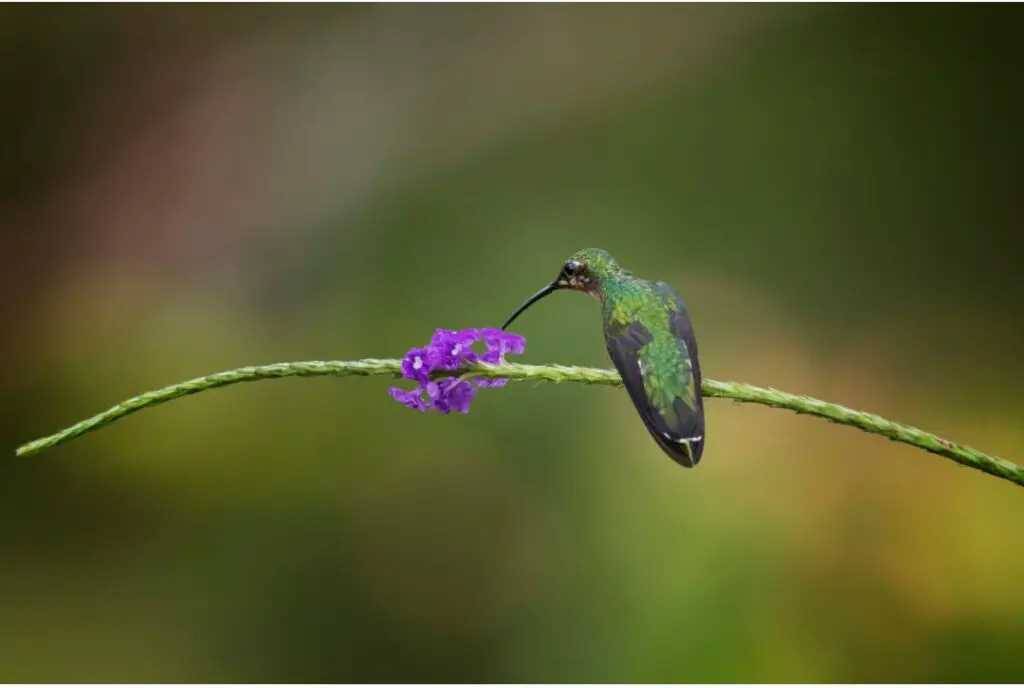
While they are not typically found in Georgia, it is possible that a Green-Breasted Mango could be seen in the State during the spring or fall migration.
You can identify the male Green-Breasted Mango by its metallic green head, throat, and breast, with a bright orange patch on the crown.
The rest of its body is a deep purple-blue color.
The female Green-breasted Mango is similar in size and shape to the male, but has a green back and wings, and a pale white or yellow breast.
Both sexes have long, curved beaks that they use to extract nectar from flowers. Both sexes are around the same size too, measuring about 4.5 inches in length and with an average wingspan of about 3 inches
Like most species of Hummingbird, the Green-Breasted Mango feeds primarily on nectar from flowers.
They are also known to eat insects and spiders, which provide them with protein and other nutrients that are important for their health and reproduction.
To get to the nectar they crave so much, Green-breasted Mangos use their long, curved beaks to access the nectar in deep-throated flowers.
They are also able to hover in place while feeding, thanks to their powerful wings that can beat up to 80 times per second!
Green-breasted Mangos are important pollinators too, as they transfer pollen from flower to flower as they feed.
They are also attracted to artificial nectar sources, such as Hummingbird feeders, so if you’d like to attract this beautiful little bird into your garden be sure to stock yours with sugar water nectar.
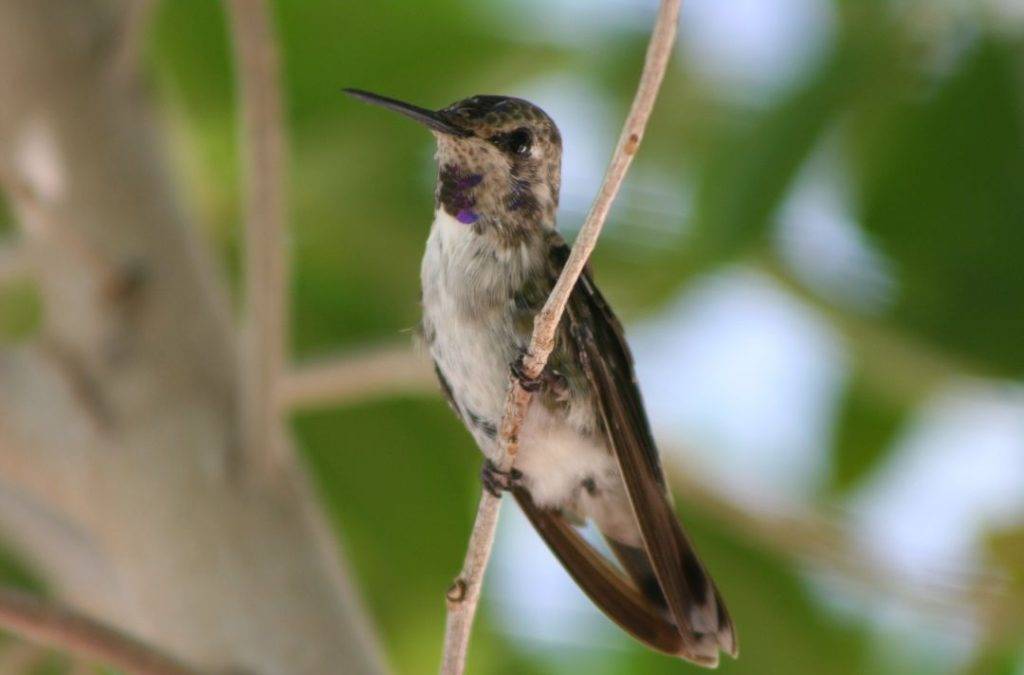
The Black-Chinned Hummingbird can be found in several parts of the United States, including Georgia.
Migratory birds, the Black-Chinned Hummingbird typically arrives in Georgia in April or May.
They aren’t overly fussy when it comes to setting up their home, and they can be found in a variety of habitats, including gardens, wooded areas, and open areas with flowering plants.
Black-chinned hummingbirds are most commonly found in the Eastern and Central parts of Georgia.
You can identify the male Black-Chinned Hummingbird by its black chin and throat, which gives them their name.
The rest of their upper body is metallic green, and their underparts are white with a pale green tinge.
Females Black-Chinned Hummingbirds are similar in appearance, but they have a white throat with a faint green or purple tone, and their underparts are white with a faint green or purple tinge.
Both males and females have a thin, straight bill that is adapted for feeding on nectar from flowers.
In terms of size, the Black-Chinned Hummingbird measures around 3.5 inches in length and has an average wingspan of 4-inches.
Black-Chinned Hummingbirds feed on nectar from a variety of flowers. They are opportunistic feeders and will visit a variety of flowering plants, including native wildflowers, as well as exotic ornamental plants in gardens.
In addition to nectar, Black-Chinned Hummingbirds also consume insects and spiders, which provide them with protein and other essential nutrients.
They feed on insects by catching them in flight, or by picking them off plants.
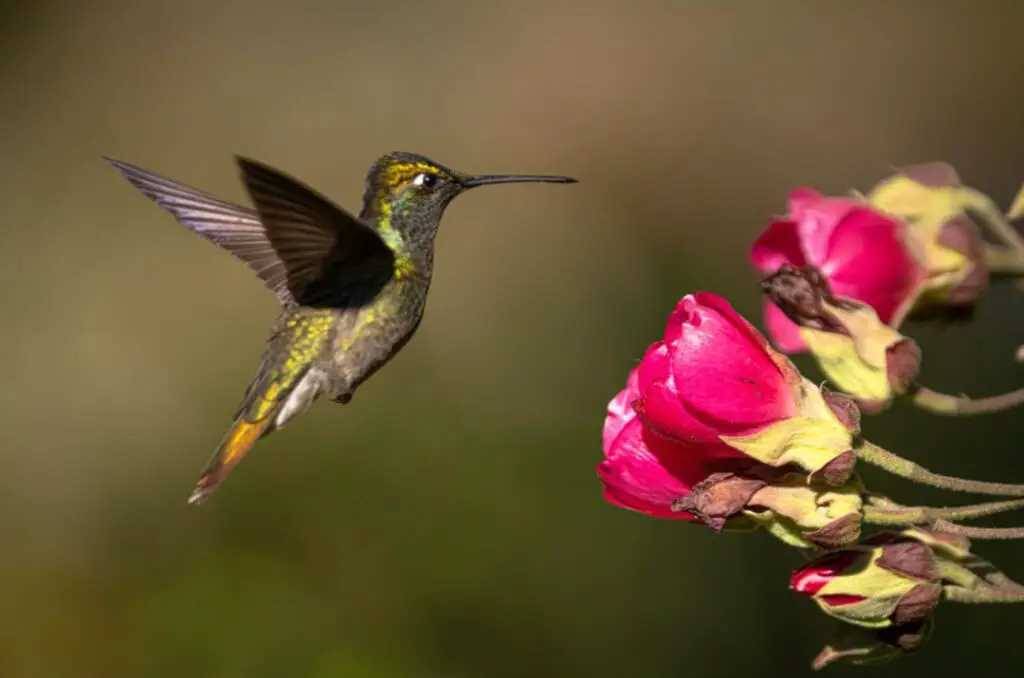
The Rivoli’s Hummingbird, also known as the “Magnificent Hummingbird”, is one of very few Hummingbird species that is native to the United States.
It can be found in several Southern States including Georgia, and is more commonly found during the spring and summer breeding seasons.
You can identify the Rivoli’s Hummingbird by its bright, iridescent green plumage, which appears metallic when viewed from different angles.
The male has a deep, iridescent green crown and throat, which is separated from the rest of its body by a distinctive, white band.
The rest of the male’s body is a bright, iridescent green, with a long, straight bill that is black in color.
The female Rivoli’s Hummingbird is similar in appearance to the male, but tends to be a bit smaller and has a less distinctive throat pattern.
The female’s throat is a pale green or white color, with a faint, iridescent green band around the upper part.
Both males and females have a short, square tail that is black in color and tipped with white. Rivoli’s Hummingbirds have a length of around 4-5 inches and a wingspan of around 4-5 inches as well.
Rivoli’s Hummingbirds primarily feed on nectar from a variety of flowers, using their long, straight bill to reach deep into the flower to extract the nectar.
In addition to nectar, they also consume small insects and spiders, which they catch in flight or glean from plants.
These protein-rich insects and spiders help to provide the nutrients that hummingbirds need to maintain their high metabolism and fuel their rapid flight.
You can attract the Rivoli’s Hummingbird into your backyard by planting nectar-rich flowers or by filling a Hummingbird feeder with sugar water nectar.
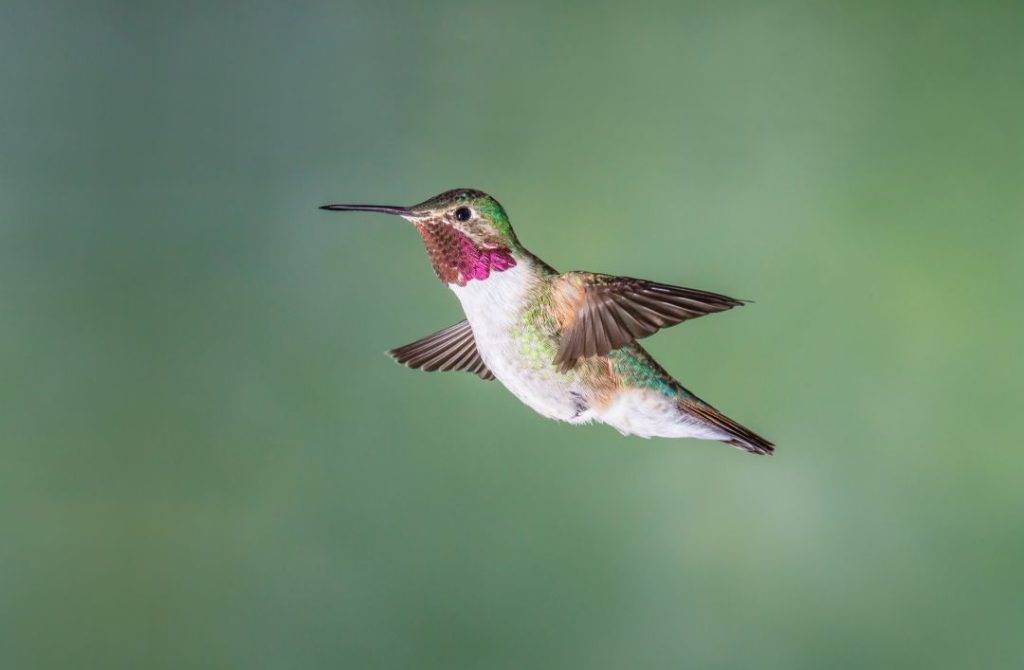
The Broad-tailed Hummingbirds is native to the western United States and Mexico.
It is also one of the most commonly spotted Hummingbird species in Georgia, and can be found in open, brushy areas and forests, as well as parks and backyards.
You can identify the Broad-Tailed Hummingbird by its distinctive physical characteristics.
These birds are small, only about 3-4 inches in length, and have a thin, pointed bill that is well-suited for extracting nectar from flowers.
Male Broad-Tailed Hummingbirds are brightly colored, with iridescent green or bronze feathers on their back and crown, and reddish-pink feathers on their throat and breast.
The feathers on their tail are also iridescent, and have a broad, rounded shape that gives this species its name.
Female Broad-tailed Hummingbirds are less brightly colored than males, with more muted green and gray feathers. They have a white or pale throat and breast, and a thin, slightly forked tail.
Both male and female Broad-Tailed Hummingbirds have a white or light-colored patch on the underside of their wings.
The diet of the Broad-Tailed Hummingbird consists mainly of nectar from flowers, which they extract using their long, thin bill.
They also consume small insects and spiders for protein, especially during the breeding season when they need extra energy to raise their young.
Broad-Tailed Hummingbirds are attracted to a wide variety of flowering plants, including native wildflowers as well as garden plants such as trumpet vines, bee balm, cardinal flower, and salvias.
They are especially attracted to red or pink flowers, which are more visible to them because they can see ultraviolet light.
In addition to nectar, Broad-Tailed Hummingbirds also need water to drink and bathe in, and they will visit bird baths or fountains to quench their thirst.
You can attract Broad-tailed Hummingbirds to your yard by providing a reliable source of nectar and water, and by planting native flowering plants that bloom at different times of the year.
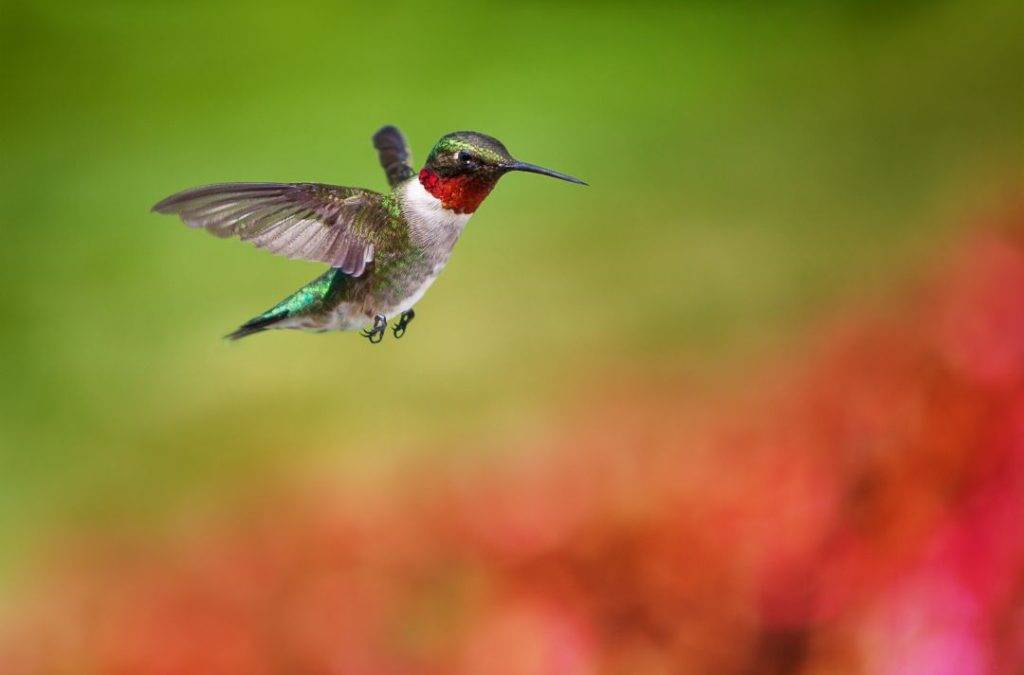
The Ruby-Throated Hummingbird is the most common Hummingbird species in the eastern United States, including Georgia.
It is, however, a migratory bird, spending the summer months in the eastern U.S. and parts of Central America, and the winter months in Central America and Mexico.
They typically arrive in Georgia in March or April and depart in October or November.
The easiest way to identify a Ruby-throated Hummingbird is by its small size. It measures just 3-inches in length and has an average wingspan of 3.
Males have a distinctive red throat from which they take their name, while female Ruby-throated Hummingbirds have a white throat.
Both sexes have a green iridescence on their backs, long, thin beaks, which they use to reach nectar in flowers, and are capable of hovering in mid-air while feeding.
They are also known for their rapid wing beats, which produce a high-pitched humming sound.
Ruby-Throated Hummingbirds mainly feed on nectar from flowers. They also consume insects and spiders, which provide them with protein and other nutrients that are essential for their growth and development.
They are able to extract insects from tree bark, leaves, and flowers using their long, thin beaks.
Ruby-Throated Hummingbirds are also able to consume up to twice their body weight in nectar and insects each day, and must feed frequently to sustain their high metabolism.
In addition to nectar and insects, hummingbirds also consume tree sap, fruit juice, and pollen.
You can attract the Ruby-Throated Hummingbird into your garden by filling Hummingbird feeders with a solution of sugar water, which can provide them with an additional food source when natural food sources are scarce.
Choosing nectar-rich plants for your garden will also increase your chances of enticing it in.
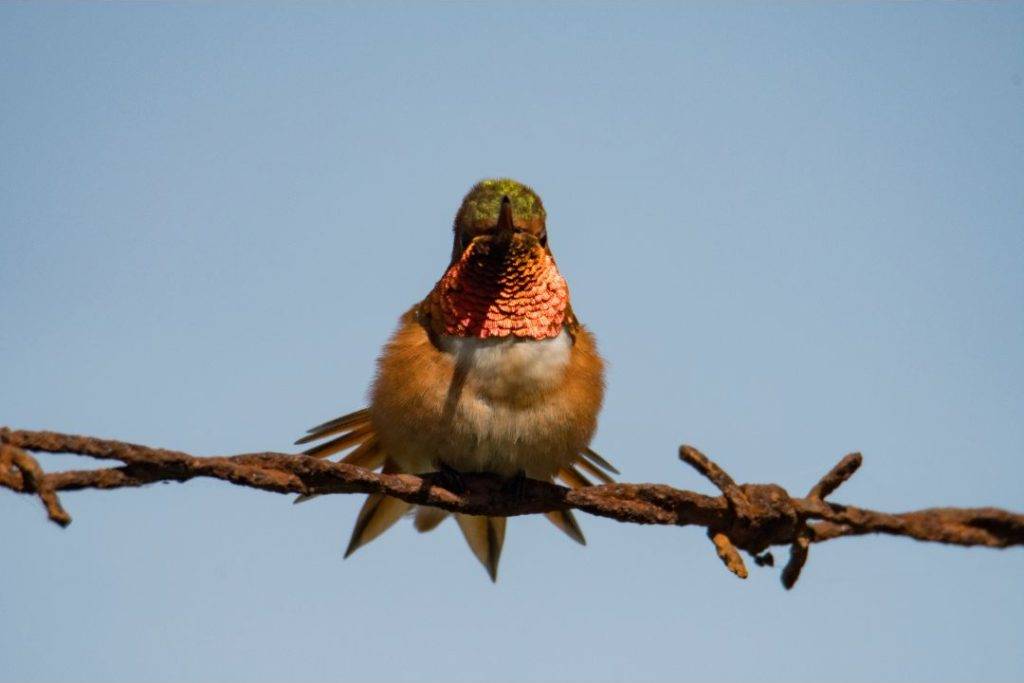
The Allen’s Hummingbird is a small species of hummingbird that is native to the western coast of North America, from southern California to southern Oregon.
It is rare to see Allen’s Hummingbirds outside of their typical range, so it is unlikely that you would find one in Georgia.
However, it isn’t impossible, and you may spot one that has strayed slightly off-path during breeding or migration seasons.
One of the smaller Hummingbird species, the Allen’s Hummingbird measures only about 3.
It can also be identified by its metallic green back and a pale underside, with a small, straight bill and a long, pointed tail.
The male Allen’s Hummingbird has a bright orange-red throat, which is iridescent and appears to change color depending on the angle of the light.
The female Allen’s Hummingbird has a pale, white throat with a few red feathers on the breast. Both sexes have a small patch of green feathers on the crown of the head.
Flower nectar makes up the majority of the Allen’s Hummingbird’s diet, which they obtain using their long, thin beaks.
They also feed on small insects and spiders, which they catch while in flight or while hovering in place.
In order to obtain enough energy to fuel their high metabolism, the Allen’s Hummingbird needs to feed frequently, often visiting hundreds of flowers in a single day.
They are able to extract nectar from a wide variety of flowers, and are important pollinators for many plant species.
Honeysuckle and bee balm are among the Allen’s Hummingbird’s favorite flowers to feed from, so be sure to include these in your planting scheme if you’d like to attract this colorful little bird into your backyard.
You can also encourage them to visit by filling a Hummingbird feeder with sugar water nectar.
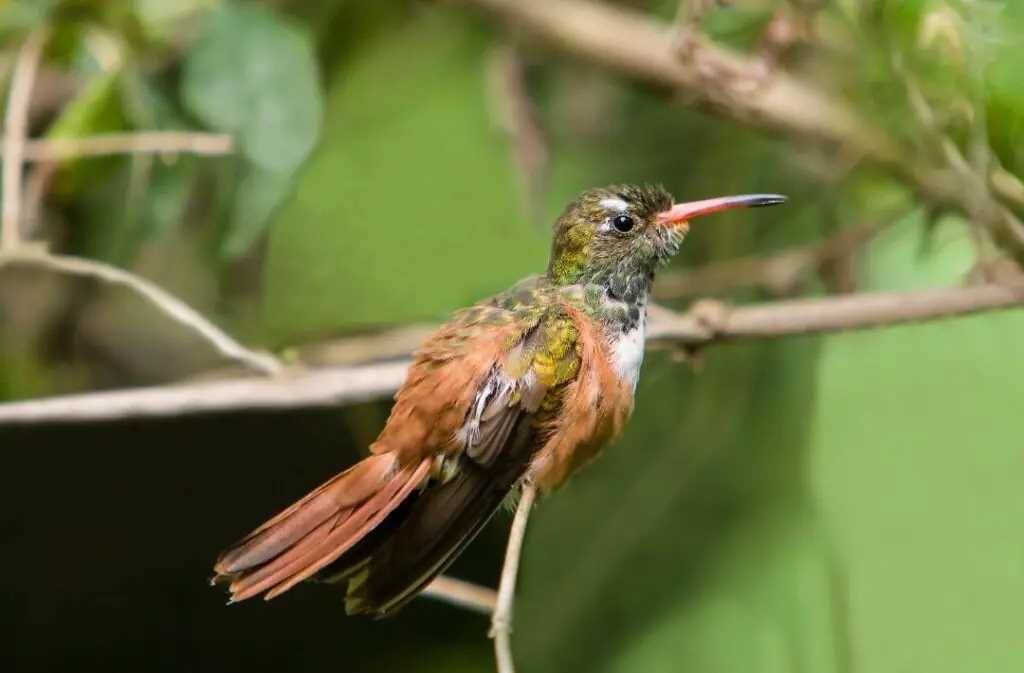
The Buff-Bellied Hummingbird is not very commonly found in Georgia, as it is not a species that is native to the United States.
However, some have been spotted in the State over the years and are considered an “accidental species”.
This means they may have ventured a little too far when migrating or have chosen to nest in Georgia that year if the climate has been particularly good.
You can identify the Buff-Bellied Hummingbird by its bright green back, namesake buff-colored belly, and dark green crown.
The male Buff-Bellied Hummingbird has a green throat with a violet-blue border, while the female has a white throat with a green border.
Buff-Bellied Hummingbirds feed on the nectar produced by flowers. They are able to hover in mid-air while feeding on nectar, using their long, pointed bills to access the nectar inside the flowers.
They are also able to fly quickly and maneuver through tight spaces, making them well-suited for feeding on nectar from small, tube-shaped flowers.
In addition to nectar, Buff-bellied Hummingbirds also feed on insects and spiders for protein, which is important for their growth and development.
They may catch insects in mid-air or pick them off plants and trees. In the winter months, when nectar is scarce, they may rely more on insects as a food source.
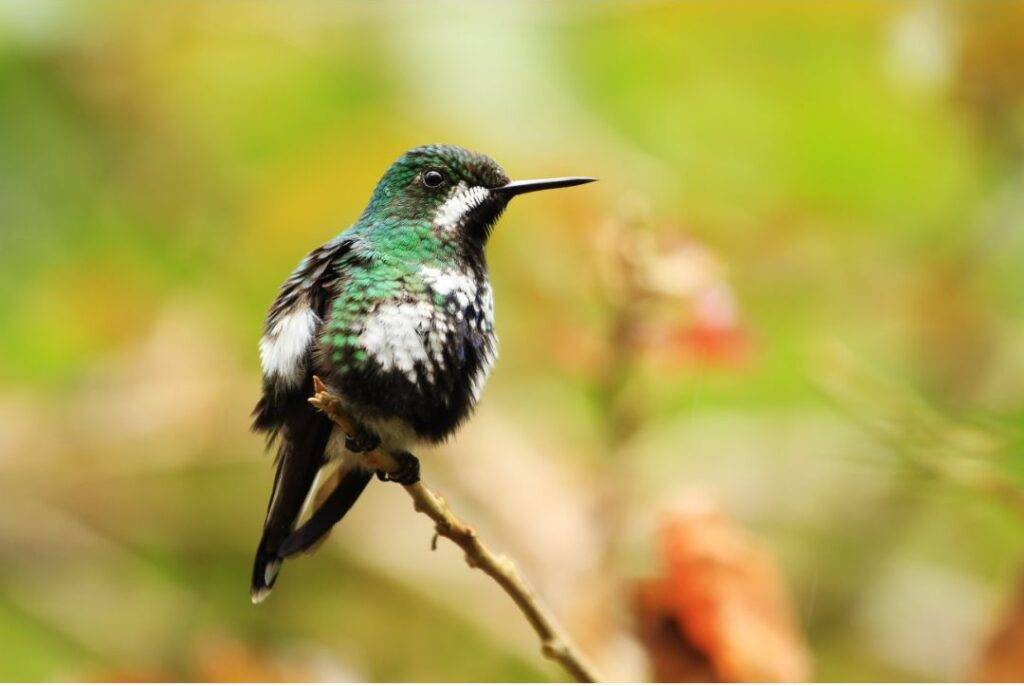
One of the rarest Hummingbird species in Georgia, the Blue-Throated Mountain Gem is most commonly found in the mountains of Central America.
It is not native to Georgia, but It is possible that you may have spotted one that has gone a little off-course during its migration.
But how can you tell if you’ve spotted a Blue-Throated Mountain Gem in Georgia?
Well, you can identify the Blue-Throated Mountain Gem by its bright blue throat and breast, a green back and wings, and a white belly.
The male also has a reddish-pink gorget (throat feathers) that is visible when he is displaying to females.
The female is similar in appearance, but lacks the reddish gorget and is slightly smaller in size. Both sexes have a short, straight bill and a fairly long, rounded tail.
Like all hummingbirds, the Blue-Throated Mountain Gem feeds primarily on nectar from flowers.
It also consumes insects and spiders, which provide it with protein and other nutrients that are essential for its growth and reproduction.
To obtain nectar, the Blue-Throated Mountain Gem uses its long, slender bill to probe into the flowers of various plants, including shrubs, trees, and herbaceous species.
It is attracted to a variety of nectar-rich flowers, including those with red, orange, or yellow petals.
In addition to foraging for food, the Blue-Throated Mountain Gem also feeds on tree sap, fruit juice, and pollen, which provide it with additional nutrients and energy.
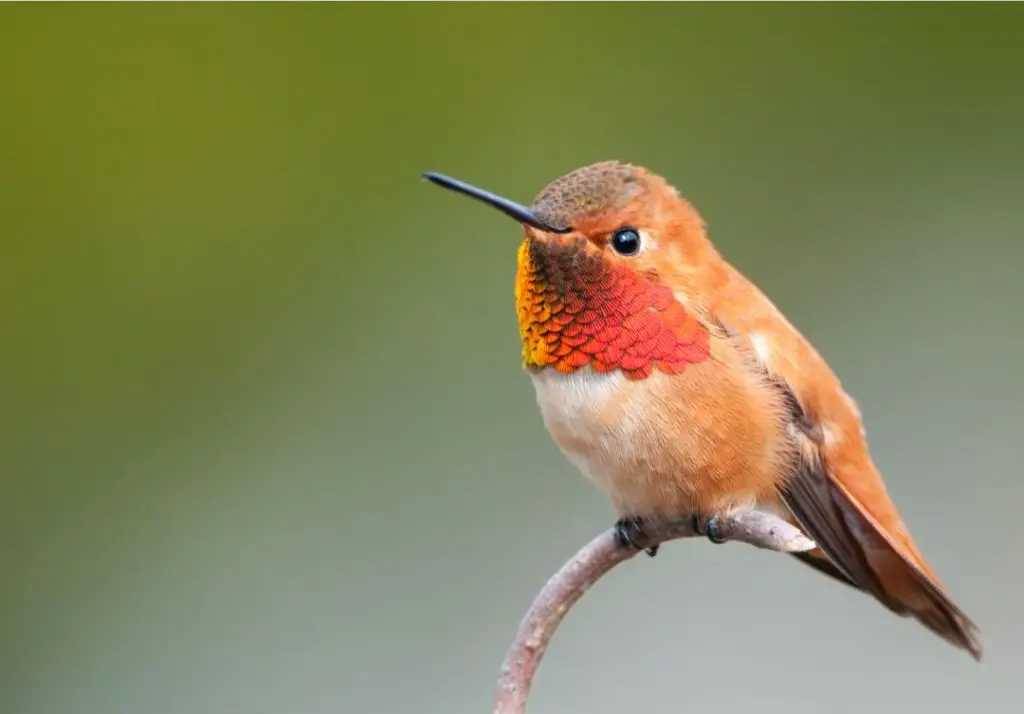
In Georgia, Rufous Hummingbirds are most commonly seen during the spring and fall migration seasons, when they are passing through the state on their way to and from their breeding and wintering grounds.
When in the State, they live in a variety of habitats, including forests, meadows, and gardens.
You can identify the Rufous Hummingbird by its small size (about 3.75 inches in length) and distinctive coloring.
Rufous Hummingbirds have a bright orange-red throat and breast, with a green back and tail.
The male Rufous Hummingbird also has a bright orange-red patch on its crown. In flight, Rufous Hummingbirds are known for their rapid wing beats and acrobatic maneuvers
Rufous Hummingbirds are mainly nectarivorous, meaning that they feed on the nectar of flowers. They also feed on small insects and spiders, which provide them with protein and other essential nutrients.
Rufous Hummingbirds have high metabolism and need to eat frequently to fuel their active lifestyle.
They feed on nectar from a variety of flowers, including red, orange, and pink ones.
They are also attracted to hummingbird feeders filled with a nectar solution, so be sure to hang one of these in your yard if you’d like to attract the Rufous Hummingbird to your garden.
There you have it – everything you need to know about all 12 species of Hummingbird you can find in Georgia. As you can see, some are much more common than others.
But, an offering of sugar water nectar and well-chosen, nectar-rich plants in your garden should be enough to encourage most of them into your home.
